What, Exactly, Is Steak Milanesa?
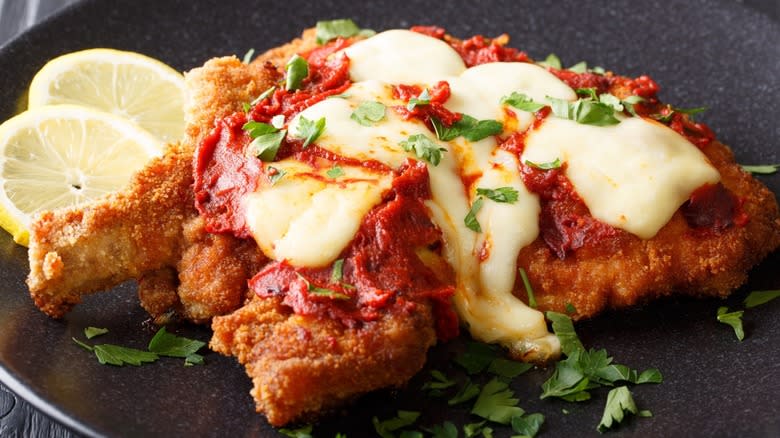
Many might consider an affinity for deep-fried foods very North American, but the international popularity of steak milanesa proves U.S. citizens aren't the only ones who appreciate a good piece of breaded, fried meat. Crafted by washing supremely thin, tenderized cuts of beef in egg before rolling them in breadcrumbs and pan-frying them, steak milanesa is one of Argentina's most favored and in-demand dishes.
While steak milanesa is strongly associated with several South American countries, its actual roots are in Milan, Italy, as its name implies. Similar to Austrian wiener schnitzel, the Italian preparation, called Cotoletta alla Milanese, employs tenderized veal cutlets rather than top round, which is generally preferred in Argentinian cuisine. Because milanesa is more so a style of preparation than a specific dish, chicken milanesa, as well as pork, beef, and veal, can all receive the same treatment.
Golden brown and crispy on the outside and tender and juicy on the inside, steak milanesa is a simple dish that allows the highly tenderized meat to truly shine. Served in fine dining restaurants, low-key lunch spots, and everywhere in between, the simplicity of steak milanesa allows the dish to transcend culture and class.
Read more: Cuts Of Steak, Ranked Worst To Best
Ingredients In Steak Milanesa
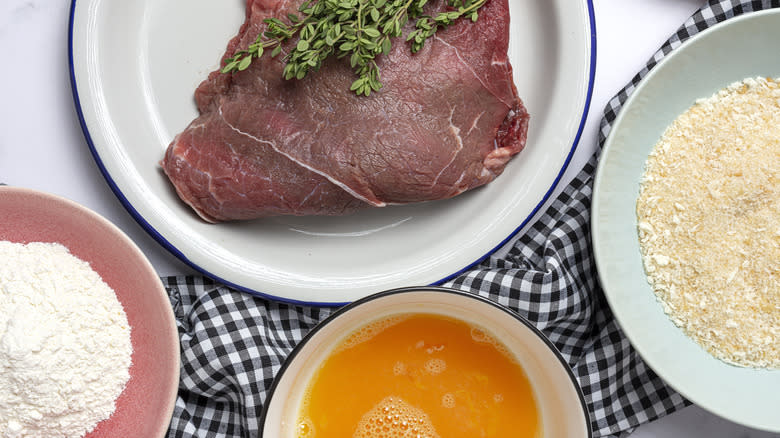
While steak milanesa can likely be found on most restaurant menus in Argentina, many locals prefer to prepare the dish themselves. Doing so isn't terribly complicated, even if it isn't your country's unofficial national dish. Any home cook hoping to prepare the meal will first need to acquire the correct ingredients. Many Argentinians will already have cuts of top-round steak stored in the freezer for this very purpose. Harvested from the top portion of the cow's hindquarters, top round cuts contain a significant amount of muscle, making for much leaner, more flavorful cuts of beef.
Making the crispy coating that gives steak milanesa its signature crunch will also require several beaten eggs, which will be used as a wash for the streak before it's rolled in breadcrumbs. Although the Italian version of milanesa is made without additional seasoning, Argentinian recipes generally call for the steak to be seasoned with salt, pepper, garlic, and parsley before it's breaded and fried in oil.
How Steak Milanesa Is Prepared
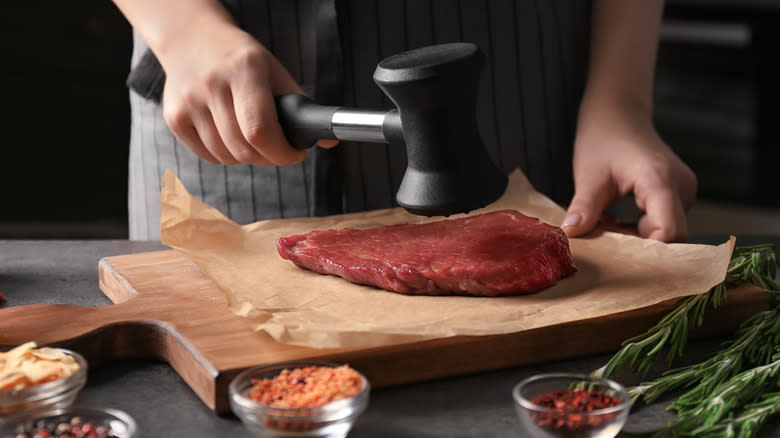
With so few ingredients, it's unsurprising that the secret to a perfect steak milanesa is in its preparation. Since the meat is the star of the show, the cut must be in perfect shape. After the chef removes any bits of excess fat, they should then tenderize the steak using a mallet or rolling pin. Once each steak is no more than ⅛ of an inch thick, it's ready for seasoning. It should then marinate in the fridge for an hour before being breaded.
With several beaten eggs in one large bowl and breadcrumbs in another, the steak is first dredged through the egg wash before being pressed firmly into the breadcrumbs. The cook may choose to repeat this process, coating the steaks a second time for an even crispier fry. The steaks should then rest for at least 30 minutes; this will reduce the chances of the breading sloughing off during the frying process.
The key to a golden-brown fry is frying oil (typically canola) that's sufficiently hot before the steaks are introduced. Once the oil reaches 340 degrees Fahrenheit, the steaks can be fried on each side for 2-3 minutes before they're placed on a paper towel-lined plate to absorb the excess oil. Often served with a light spritz of lemon juice and a side of fries, steak milanesa is the epitome of a simple pleasure.
The History Of Steak Milanesa
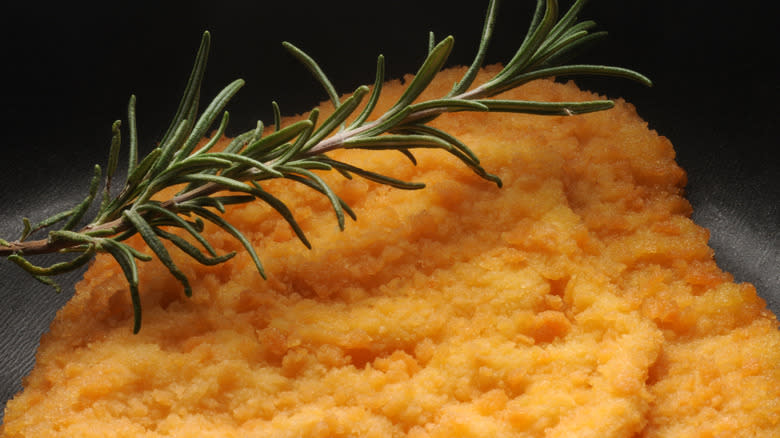
Steak milanesa is so wildly popular in Argentina that many recognize it as the country's unofficial national dish. As such, there's no denying that steak milanesa has become deeply ingrained in Argentinian culture. Before the dish was adopted by Argentinians, however, it belonged to Italy. Historically, monks stationed at Milan's Sant'Ambrogio Basilica were eating steak milanesa as far back as the 11th century, so, of course, the Milanese have been claiming the dish for centuries (despite protests from Austrians who claim that their wiener schnitzel came first).
Milanesa wasn't introduced to South America until the 19th century, when millions of Italians, fleeing poverty, immigrated to countries like Argentina, bringing local dishes like milanesa with them. With more than 2 million immigrants entering Argentina alone, today, a whopping 90% of Argentinians can trace their lineage back to Italy or Spain. As such, much of the local culture and cuisine are influenced by those of Italy.
Variations Of Steak Milanesa
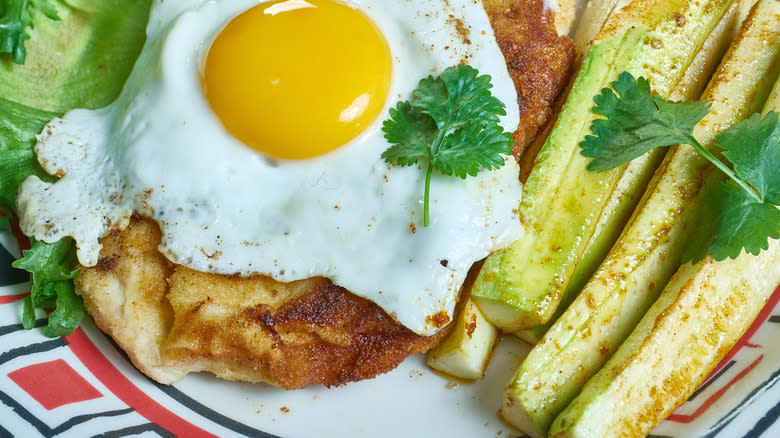
In Argentina, Uruguay, Paraguay and Bolivia, where milanesa is king, the breadcrumb-crusted steaks are often topped with nothing more than a squirt of lemon juice — if that — and served with a side of fries, mashed potatoes, or salad. Other variations of the dish, like milanesa caballo and Milanesa Napolitana, have acquired widespread popularity, as well.
Milanesa caballo, which translates to "milanesa on horseback," is made by positioning two fried eggs on top of the breadcrumb-crusted steak — the playful name suggests the eggs are riding on the steak's back. Milanesa Napolitana, on the other hand, is topped with ham, tomato sauce, and mozzarella cheese, a play on the popular Italian dish veal parmesan.
While one might assume that Milanesa Napolitana is the city of Naples' take on the popular dish, it's actually named after its creator, Argentinian restaurant owner Jose Napoli. According to legend, Napoli added sauce, cheese, and ham to the dish to hide the fact that he burnt a plate of milanesa that was meant for a famous local boxer. Well-received by the local celebrity, Napoli later added the dish, called milanesa napolitana, to his restaurant's menu.
Where To Buy Steak Milanesa
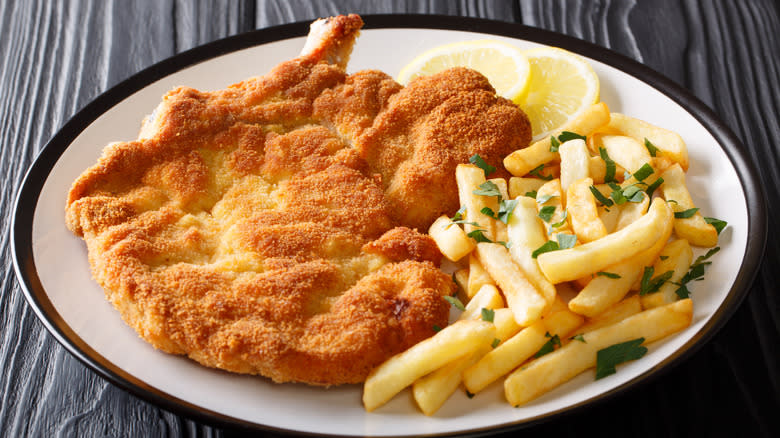
If all this steak milanesa talk has given you a hankering, you might be wondering how you can get your hands on some. In South American countries where steak milanesa is popular, particularly Argentina and Uruguay, you would be hard-pressed to find a restaurant that doesn't serve milanesa. Though it may go by different names, variations of the dish are also served in restaurants in several European countries, such as France, Italy, Austria and Germany. Many local eateries throughout Mexico also have a similar version of the dish called milanesa de res.
If traveling abroad for milanesa isn't on the docket, a version of milanesa, often called chicken fried steak, is commonly on diner and restaurant menus throughout the Southern United States. With just a handful of readily available ingredients, however, even the most amateur home cook can whip up a steak milanesa at home. Served in any of the traditional Argentinian ways or piled on a sandwich, the crispy, fried steak is sure to impress — after all, it's fried.
Read the original article on Mashed.

